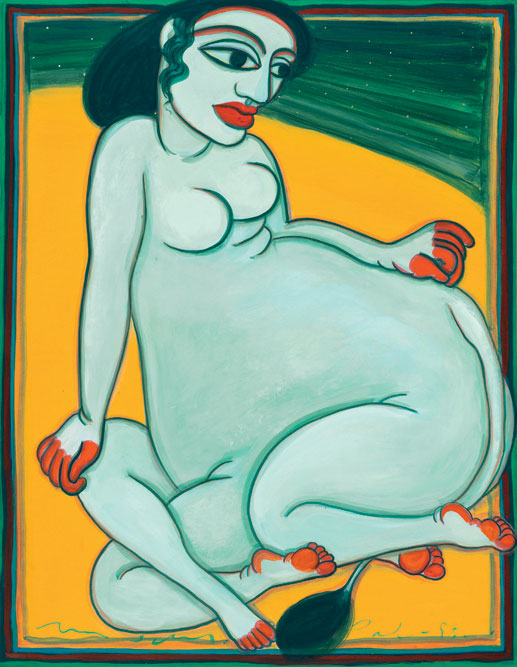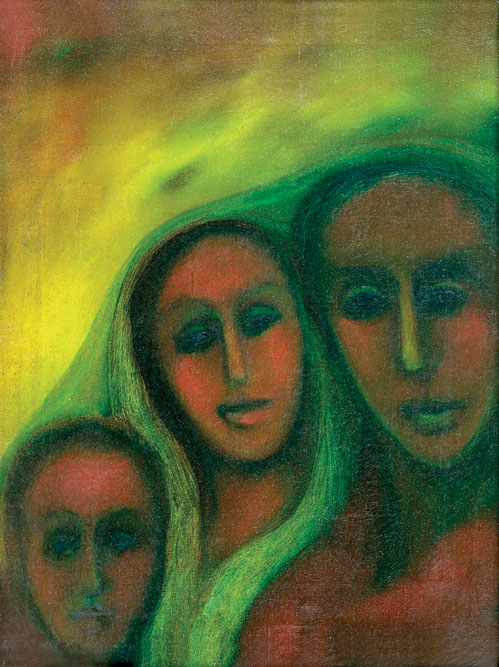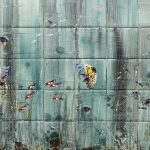Gogi Saroj Pal: Figures of Defiance
The trailblazing feminism of Gogi Saroj Pal
 Noor Anand Chawla
Noor Anand Chawla
 Noor Anand Chawla
Noor Anand Chawla
 |
12 Apr, 2024
|
12 Apr, 2024
/wp-content/uploads/2024/04/FigureofDefiance1.jpg)
Gogi Saroj Pal (Photos Courtesy: DAG)
GOGI SAROJ PAL is often hailed as one of the first ‘feminist’ women painters in modern Indian art, even though the artist herself disliked being described as such. Her women figures are empowered and self-contained. Her colourful and thought-provoking works move beyond the tropes of coy nayikas towards a more potent female form. “To be liberated, a woman must first feel free to be herself,” is the mantra Pal used to explain both her singular personality, and her art. Over a career that spanned six decades, Pal , who died in January 2024, created a narrative that was uniquely her own.
To honour her contribution to the art world, DAG, New Delhi is currently running its second retrospective of the artist’s work after a gap of 12 years. Gogi Saroj Pal: Mythic Femininities includes a selection of paintings, prints, mixed-media works and sculptures of Pal’s famed female and anthropomorphic protagonists that best represent her artistic practice. A book of the same name has also been launched along with the exhibition. It contains essays on Pal’s practice by curator and educator Roobina Karode, writer and publisher Urvashi Butalia, Pal’s husband and a fellow artist Ved Nayar, and other family members and friends.
“To understand Gogi’s practice, you need to position her among a body of women artists in this country who were primarily responsible for breaking the glass ceiling,” explains Kishore Singh, senior vice president, DAG. Her contemporaries included the likes of Shobha Broota, Anupam Sud, Arpita Singh, and Zarina Hashmi and together they formed the army of women artists who defined Indian modernism in the latter half of the 20th century.
“However, Gogi’s practice always stood apart. Her own feisty personality fuelled her work with passion and positivity even as it set no store by patriarchy. There is plenty of beauty in her art but behind that beauty, she has created a very strong underlying message about questioning the otherisation of any person or object. She was definitely a feminist but more importantly, she was a humanitarian,” adds Singh.
Pal was born in 1945 in Neoli, Uttar Pradesh, though her family belonged to Kangra, Himachal Pradesh. Her father Dharam Pal was a freedom fighter who was tortured by the British, and her uncle Yash Pal was a famous litterateur. She was raised primarily by her grandmother Prem Devi, who was one of the rare salaried women, working over a century ago. As such, her feistiness was encouraged from a young age. Singh shares stories of Pal beating up the boys at school and learning to defy expectations even at that tender age.
She studied art in Lucknow, followed by a few months at College of Art in Banasthali, Rajasthan where she learnt miniature painting. However, she shunned realism and created her own distinct artistic language consisting of bold characters and splendid colours. She was unafraid to experiment with mediums, having tried her hand at paintings, sculptures, installations and digital prints among others. Much of her work over the years focused on showing the varying aspects of womanhood—from freedom to sexual desire, agency to power. She did it all through her unique characters whose origins often lay in ancient myths. There were nayikas, kinnaris, Kamdhenus and dancing horses among other creatures, but there were also regular women.

“Rarely do I get a chance to dedicate two independent exhibitions entirely to a single artist. Gogi Saroj Pal: Mythic Femininities has been in development since the beginning of 2023, and all of us within the organisation wanted Gogi to be the centre of the exhibition when we opened our doors. In many ways, Gogi became at once a rubric as well as a fountain of wisdom to navigate difficult questions about male-female dynamics and aesthetics. In DAG’s mosaic, her art is a crucial puzzle piece, and thus has found pride of place in all our galleries many times over,” says Ashish Anand, CEO and MD, DAG, while describing the appeal of the artist.
On display at the exhibition is a wide range of work, dating back to a few still lifes from Pal’s art college days, and ending with some of her most recent sculptures. She began making the sculptures just before the pandemic in her quest to express herself in a new way. Both sculptures in the exhibition focus on a strong female protagonist with Gogi’s signature elements on display. There are bright colours, voluptuous curves, reddened lips, alta-laden hands and feet, and one of them is complemented with flowing, open hair.
A royal blue figure titled I Will Draw My Own Laxman Rekha, defies conventions of patriarchy with her wide-legged stance. Another figure, painted bright green and standing atop a yellow lioness, as opposed to the traditional lion, is a carry-on from Pal’s Hathyogini series. This Hathyogini-Kali is Pal’s way of portraying the goddess in a more gentle yet subversive avatar.
Gogi Saroj Pal’s legacy to art should not be underestimated. By combining fantasy and reality she questioned and reimagined how both gods and women are depicted
Related to these newer sculptures is her older nayika series from the 1990s. In these smaller gouache-on-paper works, her beautiful female protagonists are shown completing their toilet. They sit naked but dolled up and are depicted as self-absorbed. Her penchant for colour pops out through the strong backdrops within which these women recline, and the borders of these works seem inspired by those of miniature paintings. Singh explains, “These nayikas have a great sense of beauty but it’s only for their own pleasure. Through them, Gogi addresses the idea of desire. None of the Indian female artists before her ever did that. Female desire was always painted through a male gaze. Gogi’s women don’t allow you to engage with their bodies. They are only interested in themselves.”
This self-absorption is also the hallmark of the artist’s work centred on hybrid human-animal mythological creatures. Perhaps the most fascinating of her mythological feminist creatures are the woman-bird winged hybrids known as Kinnaris. In a few vividly painted large canvases titled Homecoming, these Kinnaris are depicted flying over lush, green forests in search of their home. However, they also seem acutely aware that having once left their home, it is impossible to return to the same time and feeling.
Her Kinnari Mantras made in the late 2000s are more introspective, as they were made when she was confined in bed for years, following a hip injury. Here, the Kinnari is shown with a lame leg. It is surrounded by mini versions of itself in the borders, as a repeated pattern, akin to the chanting of a mantra.
The Kamdhenu series, also from the 1990s, is another good example of this. As a play on the mythical wish-fulfilling cow of the same name, Pal creates half-woman-half bovine creatures decked out in traditional finery. Yet, unlike the nayikas, these females bear a melancholic expression. This was Pal’s way of questioning the role thrust upon Kamdhenu. While she is revered as the fulfiller of wishes, has anyone ever thought to ask her what she may want?
Her Dancing Horse depicts a similar quandary. In certain North Indian traditions, horses are trained to dance at weddings. Pal feels this practice goes against the very nature of the animal. “This questioning is a very strong part of what she paints,” summarises Singh.
An in-depth study of her work shows that women may be the focal point of the questions she raises, yet she is also concerned with general ‘otherisation’. This is best seen in her works from the 1980s. In Relationship, a loyal pet is shown sitting at the foot of its female master, who loves and cares for it only as per her own convenience.

The Halley’s Comet series shows the stronghold that society and superstition have on women. Here, a series of expecting and new mothers are shown naked and pensive, as they have been instructed to stay indoors and refrain from eating and drinking during the passage of the comet, to protect the health of their children.
An entire section of the exhibition is dedicated to a series of self-portraits. Butalia describes these works as “arresting and haunting”, while sharing the circumstances under which they were made. In 1989, while on an artist’s retreat in Kashmir, Pal was subjected to curfew as firing and violence broke out. Hence, these portraits captured Pal’s inward gaze as she found herself restrained in a hotel room.
To viewers, however, this melancholy isn’t explicitly visible. The artist’s endearing form depicted here gives a glimpse into her effervescent personality. Those who knew her recall her ability to form lasting friendships that flourished over cups of tea, cigarettes (she remained a chain smoker till the end) and stories.
Three playful paintings from her later years are also included in the exhibition. These are Paper Boats—Vision of Dream, It is Raining Outside, and All These Flowers Are for You (Earth). Here the female protagonists are engaged in intimate acts of self-care. That includes sailing paper boats on a river, and revelling in the freedom of leaving one’s hair down and enjoying the rain. The last of these works is the only one included in this exhibit where she experiments with the digital medium. After a memorable visit to Bali, Indonesia, she decided to post a digital backdrop of the temples there, which she foregrounded with her brightly painted female figure, clad in a garment covered in beautiful flowers.
Having died at 78, Pal’s legacy to Indian art should not be underestimated. By combining fantasy and reality she questioned and reimagined how both gods and women are depicted. Her naked women are unapologetic, defiant and self-sufficient. Their gaze looks away from the viewer as if they have little interest in the outside world. She used her knowledge of religious and ancient texts to create modern hybrid beings, who were both ordinary and extraordinary.
Singh summarises the work of Pal when he says, “Gogi’s brush strokes were so politely made. It shows you that she was never aggressive in asking questions. Creating art that stays with you as an image and as a question is what makes Pal’s work one for the ages.”
(Gogi Saroj Pal: Mythic Femininities is on display at DAG, Delhi till May 25)
About The Author
MOst Popular
3

/wp-content/uploads/2025/07/Cover-Shubman-Gill-1.jpg)












More Columns
Trump’s Disruption of World Trade Krishnan Srinivasan
Author Thomas Suárez presents peace framework for the Palestine-Israel crisis Ullekh NP
Shubhanshu Shukla Returns to Earth Open